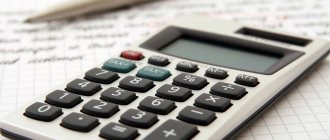What is income tax
This direct tax is levied on legal entities, and it is calculated from the amount of final profit generated at the end of the reporting period - from the profitability of the institution obtained after deducting the expenditure part. Collection operations are regulated by Chapter 25 of the Tax Code of the Russian Federation.
Legal entities are required to deduct a certain percentage of their income and send this amount to the budget system of the Russian Federation. Calculating income taxes in 2021 is an example of a critical operation that an accountant must perform correctly. If the fee is calculated with errors, the organization faces penalties from the Federal Tax Service. Our material provides up-to-date information: income tax - calculation, example for dummies, formula and calculation procedure.
So, the payers of the fee are legal entities that receive profit and are subject to the general taxation regime. Foreign enterprises (including those working through Russian representatives) conducting business on the territory of the Russian Federation and receiving income from financial and economic activities in the Russian Federation are required to pay tax. We will demonstrate with an example how to calculate the income tax of an organization that pays the fee.
By law, these categories of taxpayers are exempt from paying tax:
- institutions under special tax regimes (simplified, UTII, Unified Agricultural Tax);
- individual entrepreneurs;
- gambling companies;
- organizations taking part in preparations for large-scale events of national importance (for example, enterprises involved in preparations for the World Cup in Russia).
Basic rates
Calculate income tax at the rate for 2021 for taxpayers under the general tax regime - 20% of the obtained financial result of the activity. Until 2021, organizations contributed 18% to the regional budget and 2% to the federal budget. From the end of 2021, a different breakdown by budget level came into force (Order of the Federal Tax Service of the Russian Federation No. ММВ-7-3 / [email protected] dated 10/19/2016). Now taxpayers transfer 17% to the regional budget and 3% to the federal treasury. Local governments have the opportunity to reduce the tax rate transferred to the treasury of a particular region, but the regional rate should not be less than 13.5%, and the minimum overall rate should not be less than 16.5%.
Let's look at an example of how to calculate income tax for the general tax rate. Each region has established minimum values for certain types of taxpayers. For example, in Moscow, a reduction in the tax burden to 13.5% is confirmed by the Federal Tax Service for enterprises that employ people with disabilities, produce vehicles, or represent special economic zones, technopolises and industrial parks. In St. Petersburg, only those payers who work in the territory of the special economic zone pay a simplified regional contribution of 13.5%.
Some categories of taxpayers pay fees at special rates, the accrued amounts of which are sent exclusively to the federal budget. Special rates apply to the following categories of payers for certain types of income:
- foreign companies that do not have a Russian representative office, producing hydrocarbons and controlled foreign companies - 20%;
- foreign companies without a representative office in Russia pay a tax on income from the rental of vehicles and for international transport - 10%;
- Russian enterprises from dividends of foreign and Russian companies and from dividends from shares on depositary receipts - 13%;
- foreign companies receiving dividends from Russian enterprises and owners of yield on state and municipal securities - 15%;
- companies receiving income from interest on municipal securities and other income, according to paragraphs. 2 clause 4 art. 284 of the Tax Code of the Russian Federation - 9%.
Medical and educational institutions, residents of special economic zones and free economic zones in Crimea and the city of Sevastopol, organizations participating in regional investment projects and operating in the territory of rapid socio-economic development are exempt from paying the fee.
The tax base
The tax base is a value in monetary terms equal to the organization’s profit acquired for a specific period.
It is determined on a cumulative basis throughout the year (Article 274 of the Russian Tax Code) as follows.
Characteristics of the object of taxation
NB = Doh-Ras-Ub-Doh1-Ubpl,
Where:
- Dokh – income from the sale of products, non-operating income.
- Ras – expenses for production and subsequent sales, non-operating expenses.
- Loss – losses on transactions for which settlement occurs in a special manner. These include actions related to:
- sale of depreciable objects (Article 268);
- work of service farms (Article 275.1);
- activities of participants in a trust management agreement (Article 276);
- securities (Article 280);
- compliance with the terms of the production sharing agreement (Article 346.38).
assignment (assignment) of rights of claim (Article 279);
If a negative result is obtained after calculations, the tax base will be recognized as zero.
The general formula for calculating income tax corresponds to the following diagram:
Calculation of income tax
Example of income tax calculation
To visualize the calculation of profit collection, it is worth looking at an example.
The income of the Ivanov and Co. organization over the past year was 3 million rubles. Expenses for the same period amount to 1.5 million rubles.
- First of all, it is necessary to calculate the tax base, which is equal to the difference between income and expenses - 1.5 million rubles.
- The tax rate corresponds to 20%.
- Amount payable to the state budget = 1.5 million * 20% = 300 thousand rubles. Of these: 30 thousand rubles (2%) will go directly to the federal budget, 270 thousand rubles (18%) will go to the regional budget.
In the example under consideration, tax calculation does not present any difficulties, but in real practice, the interested party will need to take into account many subtleties and pitfalls.
Assets and Liabilities
In most cases, when calculating the tax base, many nuances arise, the consideration of which is considered necessary to comply with the law.
Tax assets and liabilities are calculated according to permanent differences and temporary differences.
Deductible temporary differences (DTD) form a deferred tax asset equal to: TDT*20%. Taxable temporary differences (TDT) are the basis for calculating the amount of deferred tax liability = TDT * 20%.
Flowchart for analyzing deferred tax assets and liabilities
The permanent tax liability is the difference between the amount of the contribution in accounting and tax accounting. The resulting figure means that in this period the amount payable on the mandatory deposit was increased.
The reverse output reflects a permanent tax asset.
To understand the behavior of assets and liabilities in transactions, it is worth looking at an example:
| Debit | Credit | Operation performed | Amount (in rubles) | Document |
| 99 | 68(Fd) | Mandatory contribution to the federation. budget | 20 000 | Reference |
| 99 | 68(Rg) | Mandatory registration fee budget | 180 000 | Reference |
| 68 | 99 | PNA accrued (66,000 * 20%) | 13 200 | Reference |
| 68 | 99 | Conditional income for NP is indicated (566,000 * 20%) | 113200 | Reference |
So, using entries for conditional income (expense), it is possible to ensure equalization of the difference in the amount of the mandatory contribution that exists between tax and accounting accounting.
Tax rate
The levy rate on profits is generally 20%. Of these: 2% is allocated to the federal budget, 18% to the regional budget.
Article 309 of the Tax Code of the Russian Federation regulates the issue of calculating the mandatory contribution for foreign organizations whose activities do not occur through a permanent representative office on the territory of the Russian Federation.
In this case, the entire amount of the mandatory contribution goes only to the federal budget. In such cases, the rate will differ from the general one if the foreign company uses, maintains and leases sea, air and other types of mobile transport (including containers).
Profit collection rates
If the tax base is formed from income received in the form of dividends, then reduced rates are used (the entire amount goes to the federal budget):
- for Russian individuals and legal entities - tax residents of the country - when purchasing positive accruals from Russian legal entities, the percentage is 9%;
- for foreign legal entities when purchasing positive accruals from Russian legal entities, the percentage is 15%;
- for Russian legal entities when purchasing plus accruals from foreign legal entities, the percentage of payments is 15%.
Also, different rates are typical when forming a base from income received in the form of interest on securities and bonds. In particular:
- 15% – from state and municipal securities (issued after January 1, 2007)
- 9% – from municipal securities (validity period must exceed 3 years), from mortgage-backed bonds, from the acquisition of mortgage participation certificates; all positions issued and released before January 1, 2007;
- 0% – on state and municipal bonds issued before January 20, 1997, on state foreign currency loan bonds issued in 1999.
Subjects of the Russian Federation may, by their decision, reduce the percentage for certain categories of payers to 13.5%.
VAT is calculated using the following rates:
VAT calculation
Calculation formula
All step-by-step instructions on how to calculate income tax come down to using formulas. You will find the figures for them in the balance sheet and in the reporting. To calculate the amount of income, use the formulas:
TNP = D – PNO + SHE – IT;
TNU = R – PNO + SHE – IT,
Where:
- D - enterprise income;
- R - expenses of the enterprise;
- PNO - permanent tax obligations;
- ONA - deferred tax assets;
- ONO - deferred tax liabilities;
- TNP - current income tax;
- TNU - current tax loss.
Calculation examples
Let's look at an example of calculating income tax for a financial year. Let's say the company is on the general taxation system. Income for the reporting period amounted to 6,000,000 rubles. Costs for the same period are 2,000,000 rubles. Thus, net profit: 6,000,000.00 – 2,000,000.00 = 4,000,000.00. Here are instructions on how income tax is calculated in this case:
- Contributions to the regional budget will be: 4,000,000.00 × 17% = 680,000.00 rubles.
- Interest paid to the federal budget: 4,000,000.00 × 3% = 120,000 rubles.
Here are instructions on how income tax is calculated if an organization belongs to a separate category of taxpayers paying contributions to the regional treasury at a simplified tax rate of 13.5:
- Local budget: 4,000,000.00 × 13.5% = 540,000.00 rubles.
- The required 3% must be paid to the federal treasury: 4,000,000.00 × 3% = 120,000.00 rubles.
Let's look at another example of calculating corporate income tax using a formula with tables - for an LLC. According to the profit and loss statement in Form No. 2, LLC “Company” received income in the amount of 600,000.00 rubles. Cost structure according to the formula:
- 5000 rub. — permanent tax liability;
- 6500 rub. - Deferred tax assets;
- 35,000 rub. — accrued depreciation (linear method);
- RUB 50,000.00 - non-linear depreciation - for tax purposes.
The deferred tax liability is: 50,000 – 35,000 = 15,000 rubles.
Income tax for the reporting period: 600,000.00 × 20% (17% + 3%) = RUB 120,000.00.
Let's reflect the accounting records by indicators in the table:
| Wiring | Sum | Contents of operation |
| Dt 99 Kt 68 | 120 000,00 | Tax payment for the reporting year is taken into account |
| Dt 99 Kt 68 | 5000,00 | Permanent tax liability carried out |
| Dt 09 Kt 68 | 6500,00 | Deferred tax assets offset |
| Dt 68 Kt 77 | 15 000,00 | Deferred tax liability accepted |
Tax returns are submitted to the territorial Federal Tax Service before the end of the reporting period (year). The organization distributes payment amounts evenly and pays them in advance - monthly or quarterly throughout the reporting period. After the end of the year, the accountant transfers the remaining amount of income tax.
Tax rates
The profit rate is calculated as a percentage and is currently legally equal to 20 units. In 2021, the amount paid was distributed as follows:
- 2% of the “body” went to the federal budget;
- the remaining interest went to the regional treasury.
However, shortly before the start of 2021, the inspectorate issued an order that outlined an updated redistribution between state budgets. Now the federal one receives 1% more, and accordingly the regional one decreases by the same amount.
It is also possible to individually change the size of the specified tax rate. This decision is made directly by the regional authorities, who have the right to reduce payments by reducing the percentage allocated to them. However, they also do not have the right to lower the rate to less than 13.5%.
This value is considered preferential. In the capital, companies engaged in the following work are subject to it:
- produce motor vehicles;
- carry out activities in a special economic territory;
- are representatives of parks of industrial and technological policies;
- use people with disabilities as employees.
The cultural capital also established a constant rate of 13.5% for certain categories of taxpayers, including companies operating in a special economic zone.
The example of the main cities of the country is followed by most of its other subjects. Lowering the rate is a common practice. However, in addition to the variety presented, there are also specialized bets. According to them, the tax received on profit is sent in full to the federal treasury.
Note! The remaining 3% due to the federal budget must be added to 13.5%. Local authorities cannot cancel or lower them.
The use of specialized rates is made due to their special characteristics of the company:
- status;
- activities.
Table 1. Specialized income tax rates
| Bid | Characteristics of the company and income |
| 20% | From the profits received, the following are given to the state:
|
| 10% | Foreign companies that do not have representative offices in the Russian Federation transfer to the authorities the income received from leasing vehicles and carrying out international transportation. |
| 13% | Russian companies receive money from other companies, no matter local or foreign, as well as dividends from existing deposited shares. |
| 15% | Payments are made to foreign organizations, from funds received from Russian companies, as well as to all owners of profits due on state and municipal securities. |
| 9% | A rate of 9% is imposed on income from Article No. 284 of the Tax Code. |
| Zero rate | And finally, organizations whose location and work is Russia are not taxed at all. Moreover, they are of a budget nature, that is:
|
In addition, the zero rate applies to residents of the economic zone, as well as members of local investment projects, the liberated economic zone in the Republic of Crimea and the federal city of Sevastopol.
Advance payments
If the organization’s profitability amounted to no more than 15 million rubles (quarter) for the previous tax period, then it has the opportunity to pay an advance on income tax quarterly. The amount is calculated from the actual amount of income.
If the company has a profitability exceeding 15 million rubles, then it must make an advance payment monthly. An example of how to calculate an organization’s income tax: a specialist will calculate the fee based on the estimated level of income predicted based on the reporting data of the previous quarter.
Calculation of advance payments for income tax
Although the tax period for income tax is considered to be a year, the company is required to accrue advance payments. There are two methods for calculating them:
- The first is installed for all companies. The reporting periods are the 1st quarter, half a year, 9 months. At the end of each of them, advance payments are made:
- the amount of payment for the 1st quarter is equal to the calculated income tax for this period;
- the amount of the 2nd payment is equal to the amount of tax for the half-year, reduced by the amount of the transferred advance for the 1st quarter;
- the amount of the 3rd payment is the amount of NNP for 9 months, reduced by the amount of advances for 1 quarter and half a year.
The procedure for paying income tax provided for in Art. 285 of the Tax Code, grants the right to transfer quarterly advance payments to companies with revenue not exceeding 15 million rubles. (excluding VAT) per quarter for the previous 4 quarters. This right also applies to budgetary, non-profit organizations and some other enterprises, regardless of the amount of their revenue.
At the end of the quarter, the accountant calculates the amount of the payment (according to the above calculation) and compares its value with the amount of accrued monthly payments made in this quarter. If their total amount is less than the calculated quarterly payment, then the company pays the difference. In case of overpaid advances, the overpayment is counted by the accountant in subsequent periods.
Monthly advance payments for income tax are calculated as follows:
- in the 1st quarter, the accountant counts payments similar to the amounts accrued in the 4th quarter of last year;
- in the 2nd quarter, the accountant divides the amount of tax on profit accrued for the 1st quarter by 3 and transfers it in shares for each month of the quarter;
- in the 3rd quarter, the accountant subtracts the tax amount for the 1st quarter from the income tax amount for the half-year and, dividing it by 3, determines the amount of advances for the months of the 3rd quarter;
- in the 4th quarter, the amount of income tax for 9 months, reduced by the amount of income tax for six months, is divided by 3 and the amount of monthly advances is determined.
- The second method of calculation is calculating the income tax from actual profits. The company has the right to establish it in the new year by notifying the Federal Tax Service about this before December 31 of the previous year. With this method, the tax is calculated on the basis of the actual profit received, i.e., by making monthly advance transfers, the tax amount is calculated from the actual profit received for the month. For example, for January they transfer NPT from the profit of January, for February - NPT from the profit received for January and February, reduced by the amount of tax transferred in January, etc.
Expenses and income of the organization
Income is the proceeds from the main types of financial and economic activities of the institution. Income is the enterprise's revenue from third-party resources. Such sources will be funds received from leased property, loans provided, etc.
Here is an example of how to calculate income tax in 2021. When calculating the payment, net income is accepted - without deductions for value added, excise taxes, etc. Accompanying documentation must be attached to the indicated income - payment orders, invoices, accounting data from the book of income and expenses.
Expenses are costs aimed at satisfying the production, general economic and basic needs of the organization (wages, materials, equipment, etc.). Expenses can also be indirect, for example, expenses aimed at paying off interest on loans. All costs must be reasonable and documented.
What expenses are deducted from income?
To find out the amount of net profit, income is subtracted from expenses. All expenses must be confirmed and economically justified. To do this, the accountant must correctly prepare and maintain primary and tax documentation. When calculating profit, the following costs are taken into account:
- production;
- general economic;
- representative;
- transport;
- advertising, but not more than 1% of sales revenue;
- expenses for training and advanced training of personnel;
- interest on loans and credits.
What expenses are not taken into account when calculating?
When calculating income tax, the following costs are not taken into account:
- contributions to the authorized capital;
- penalties and fines;
- property and funds transferred to pay for loans and borrowings;
- advance payment for goods or services;
- the cost of property transferred free of charge and the costs of transfer;
- pension benefits;
- vouchers for treatment and rest of employees, etc.
A complete list of expenses that are not taken into account in the calculation is given in Art. 270 Tax Code of the Russian Federation.
How to reduce your tax burden with dividends
If the company’s employees are also its founders, then part of the income can be paid to them in the form of dividends. Only 13% income tax will need to be withheld from the amount issued; you will not have to pay contributions to the Pension Fund, Social Insurance Fund and Compulsory Medical Insurance Fund.
It is not possible to reduce income tax through dividends. Since, in accordance with the Tax Code of the Russian Federation, dividends are not recognized as expenses when calculating income tax.
Keep records and submit all reports to the Federal Tax Service, Pension Fund of the Russian Federation, Social Insurance Fund and Rosstat through Kontur.Accounting. Get free access for 14 days
Recognition of income and expenses
The moment of recognition of income and expenses is the period in which the receipts or expenses taken into account when calculating fees are posted. This is important for calculating income tax for dummies. The moment of recognition directly depends on the method of recognition of income and expenses. There are cash method and accrual method.
If an organization has chosen the cash method, then it must record income when it is immediately received, and expenses when funds are written off. Under the cash method, tax payments are reflected on the days of receipt. write-offs. The cash method cannot be used by banking organizations. The organization has the right to recognize profitability (costs) upon receipt (write-off) in the case where revenue is recorded in the amount of no more than 1 million rubles for each quarter (the last 4 quarters are taken into account). If revenues exceed this threshold, then the company must switch to the accrual method.
Under the accrual method, all income and expenses are recorded in accounting when they arise, and tax payments are reflected on dates confirmed by primary documents. The actual date of payment does not matter.
An institution has the right to annually choose the method of recognizing income and expenses and notify the tax office about this by December 31 of the current year.
Calculation methods
To ensure high-quality accounting, a specialist must correctly identify when acquired funds are considered income and thereby form a base, and when expenses are called tax expenses. The determination of such points depends on the method of accounting for income and expenses.
The Tax Code of the Russian Federation provides for two methods:
- Accrual method (Article 271 – Article 272 of the Tax Code of the Russian Federation). The key condition is that accounting does not depend on the actual redistribution of the money supply. This is true, since according to the provisions of the relevant articles, the date of acquisition of income from the sale of goods is considered to be the date of transfer of ownership of the product.
Accrual methodIt turns out that the accountant must take into account revenue when determining the base already on the date of shipment of the goods, even when the actual payment has not yet been received. This also applies to non-operating income, except in cases with the accrual of dividends and gratuitously received funds.
Expenses are also taken into account - they will be reflected in the reporting period to which they relate - regardless of when the payment actually occurred.
- Cash method (Article 273 of the Tax Code of the Russian Federation). A completely opposite situation is typical when using the cash method - it is impossible to take into account income and expenses when calculating the tax base until the actual transfer of money has been made.
Important: only companies with an average revenue over the past four quarters of no more than 1 million rubles for each period can use this method.
This condition must be maintained as long as the cash method is used. Otherwise, the company must switch to the accrual method from the beginning of the year.






